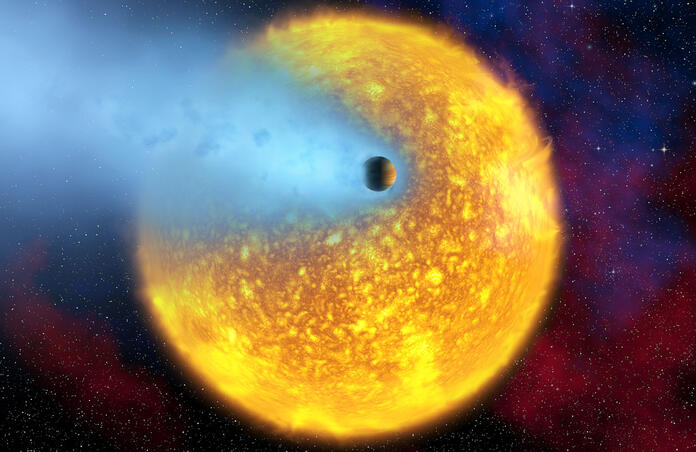Astronomers uncover insight into the painful process of planetary vaporisation

When a planet strays too close to its host star, it will begin to be slowly eaten away by the star in a painful evaporation process. Observing dying planets within close-in orbits don’t come by often, and astrophysicists tend to rely on theoretical calculations using our knowledge of physics to infer what is going on beneath the surface of planets. However, a team of astronomers have caught observations of these events from Kepler data, helping to reveal information regarding planetary formation.
NASA’s Kepler space telescope was launched in 2009 and decommissioned in 2018, designed to survey our region of the milky way galaxy. The mission focused on discovering hundreds of earth sized planets or smaller orbiting their parent stars within the vicinity of the habitable zone, a region where surface liquid water may exist. To detect such planets, the survey relies on the technique of planetary transits, where the brightness of a star is monitored and if a planet is orbiting there will be a temporary dip in brightness. Within the tens of thousands of stars observed, three systems of particular interest were seen. These systems involved an orbiting planet with a thick cloud of dust, suggesting that such systems involved a star in the process of vaporising its planet.
The team of astronomers developed simulations to model how the evaporation of a planet can proceed due to the intense radiation from its parent star, and therefore provide a better understanding of the observations. The simulations involved a range of radiation levels for the star, planet size, orbital distance and the chemical makeup/composition of the planet. Generally, it was found that when a planet wanders too close to its star, the smaller the planet the more rapid the vaporisation process. Additionally, the planet must orbit very close in order to be torn apart due to the extreme levels of stellar radiation.
The study, available on the arXiv preprint sever, finds that once a planet migrates to a close-in orbit, it will most likely become tidally locked such that one half is always facing the star (the dayside) and the other is always in darkness (nightside). The dayside will reach extremely high temperatures, which will melt and vaporise the planets rocky material, whereas the nightside will experience arctic temperatures creating an environment for the formation of water ice. These two extremities compete and within a few thousand years most of the planet solidifies due to nightside cooling. However, a thin shell of magma forms which faces the host star. The subsequent evaporation occurs due to this shell, resulting in a dusty cloud around the planet along with a trail of debris behind it in its orbit.
Two cases were found to arise from such simulations, the first being an extreme case. This scenario involved a low mass planet within a close orbit of intensely radiating star. The evaporation of the entire planet is possible before it can solidify, which results in the destruction of the planet within just a few thousand years. The other, much more common system involves the slow death of the planet as the star eats away at the extreme heated dayside for billions of years.
Researchers also determined that there is a very small window of time for these systems to be detected. There needs to be a significant flow of evaporated rocky material, therefore high temperatures and low masses are needed, however the process needs to be slow enough for the planet to still be detected. The team used the ideal evaporation conditions and the three destructive systems to estimate the total number of small planets in the entire galaxy. It was determined that for every star in our galaxy, there is one small planet with a mass smaller than Earth. However, this is not completely accurate due to the possibility of very low mass planets being missed by Kepler. A small planet will block less stellar light as it orbits and may cause an undetectable transit, going unnoticed.
Future observations using James Webb will hope to provide more insight into the nature of these dying planets by performing study of the dust clouds.
--
Cover image: NASA, European Space Agency, Alfred Vidal-Madjar (Institut d'Astrophysique de Paris, CNRS)
Journal reference: Alfred Curry et al, The evolution of catastrophically evaporating rocky planets, arXiv (2023). DOI: 10.48550/arxiv.2303.15200
